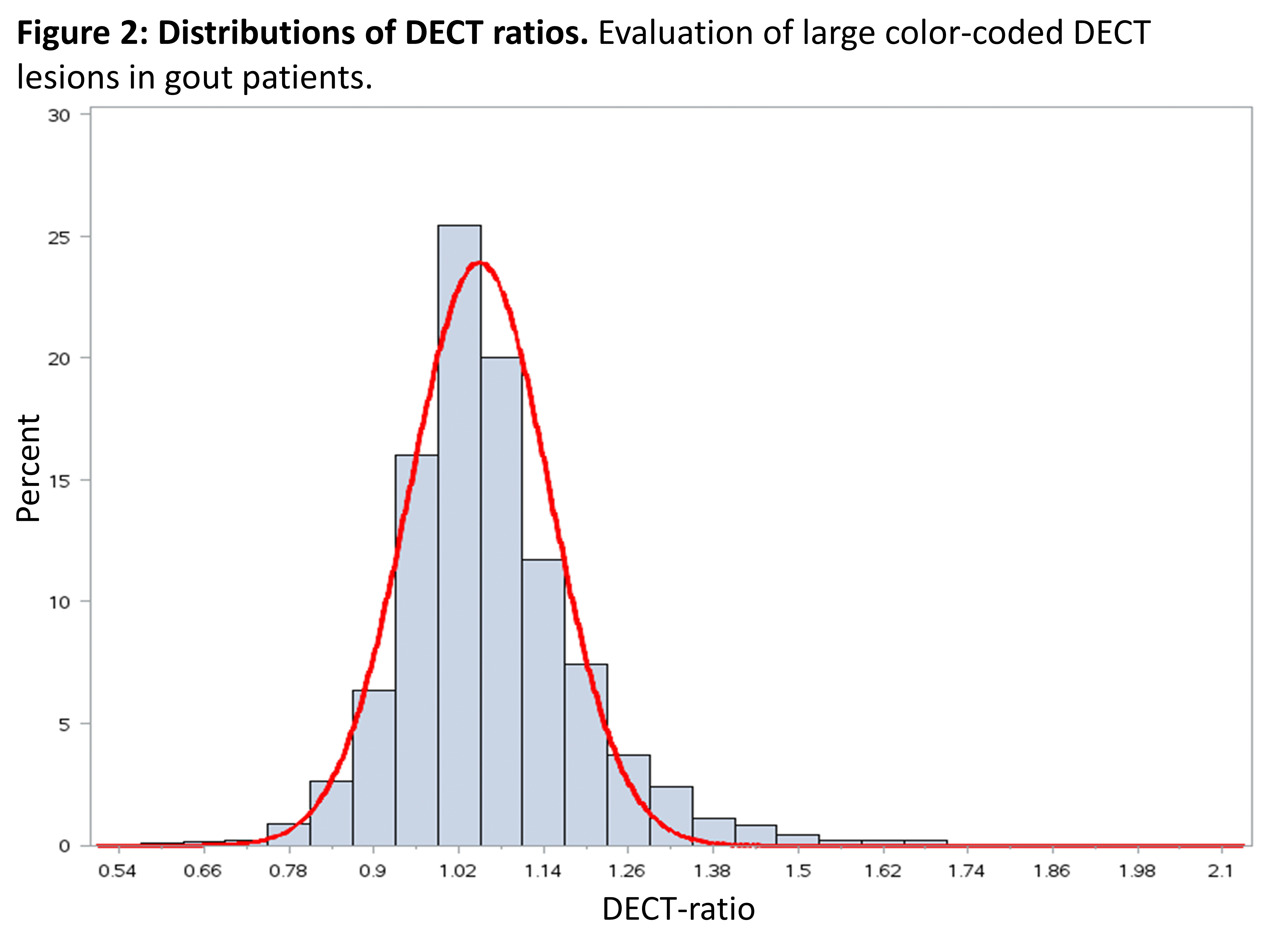Session Information
Session Type: Abstract Session
Session Time: 10:00AM-10:50AM
Background/Purpose: Dual-Energy CT (DECT) can acknowledge differences in tissue compositions and can color-code tissues with specific features including monosodium urate (MSU) crystals. However, when evaluating gout patients DECT frequently color-codes material not truly representing MSU crystals and this might lead to misinterpretations if the reader is not aware of these potential pitfalls. The variations in properties of color-coded DECT lesions in gout patients have not yet been systematically investigated.
The objective was to evaluate the properties and locations of color-coded DECT lesions in gout patients.
Methods: DECT of the hands, knees and feet were performed in patients with suspected gout using factory default gout-settings. Location-relevant colour-coded lesions were registered. For each lesion properties [mean density (mean of Hounsfield Units (HU) at 80kV and Sn150kV), mean DECT ratio and size] and location were determined.
Subgroup analysis was performed post-hoc evaluating differences in locations of lesions when divided into definite MSU deposits and possibly other lesions. Division were made according to lesion properties: 1) Size—to separate small volume artefacts (possible image noise artefacts), 2) DECT ratios—to separate calcium-containing material characterised by high DECT ratio (possible calcium-containing material). 3) Density—to separate dense tendons characterised by low DECT ratio and low HU values (possible dense tendons). Lesion fulfilling all MSU characteristics (large volume, low DECT ratio, high density) were labelled definite MSU deposits. Finally, for non-gout patients, properties of non-gout MSU-imitating lesions (properties as definite MSU deposits) were analysed.
Results: In total, 3918 lesions (all lesions) were registered in 23 gout patients with median density of 160.6HU and median size of 6 voxels (Figure 1). DECT ratios of large lesions showed an approximated normal distribution, but with a right heavy tail consistent with presence of smaller amounts of calcium-containing lesions (Figure 2). The most common locations of all lesions were MTP1, knee and midtarsal joints along with quadriceps and patella tendons (Figure 3A).
Subgroup analyses showed that definite MSU deposits had a similar distribution pattern as all lesion with the same five most common locations (Figure 3B). This was also the case for possible dense tendon (data not shown), indicating that these lesions primarily consisted of true MSU deposits. In contrast, possible calcium-containing material and non-gout MSU-imitating lesions had distinctly different properties (DECT ratios 1.33 and 1.20, respectively) (Figure 1) and furthermore showed different distribution pattern as they were primarily found in some larger joints (knee, midtarsal and talocrural) and tendons (Achilles and quadriceps), whereas non were found in either MTP1 joints or patella tendons (figure 3C).
Conclusion: Color-coded DECT lesions in gout patients showed heterogenicity in properties and locations. MTP1 joints and patella tendons exclusively showed definite MSU deposits. Hence, a sole focus on these regions in the evaluation of gout patients may improve the specificity of DECT scans.
 DECT, dual energy CT ; HU, Hounsfields Units ; ratios, DECT ratios (HU a 80kV / HU at sn150kV) ; density, (HU at 80kV+HU at sn150kV) / 2 ; size, numbers of pixels; SD, standard deviation ; IQR, interquartile range ; SD standard deviation.
DECT, dual energy CT ; HU, Hounsfields Units ; ratios, DECT ratios (HU a 80kV / HU at sn150kV) ; density, (HU at 80kV+HU at sn150kV) / 2 ; size, numbers of pixels; SD, standard deviation ; IQR, interquartile range ; SD standard deviation.
 The distributions of DECT ratios have been overlaid with a normal distribution curve with a mean at the local maxima at a DECT ratio of 1.06 and a standard deviation estimated from points below this mean to be 0.10. Notice that the right tail on the DECT ratios are heavy with more lesions having a high DECT ratio than expected by a Gaussian distribution in agreement with a mixture of monosodium-urate deposits and calcium-containing material. DECT, Dual-Energy computed tomography; DECT ratio, HU at 80kV / HU at 150kV (with tin filter).
The distributions of DECT ratios have been overlaid with a normal distribution curve with a mean at the local maxima at a DECT ratio of 1.06 and a standard deviation estimated from points below this mean to be 0.10. Notice that the right tail on the DECT ratios are heavy with more lesions having a high DECT ratio than expected by a Gaussian distribution in agreement with a mixture of monosodium-urate deposits and calcium-containing material. DECT, Dual-Energy computed tomography; DECT ratio, HU at 80kV / HU at 150kV (with tin filter).
 MCP, metacarpophalangeal joints; PIP, proximal interphalangeal joints; DIP, distal interphalangeal joints; MTP, metatarsophalangeal joints.
MCP, metacarpophalangeal joints; PIP, proximal interphalangeal joints; DIP, distal interphalangeal joints; MTP, metatarsophalangeal joints.
To cite this abstract in AMA style:
Christiansen S, Müller F, Østergaard M, Slot O, Møller J, Børgesen H, Gosvig K, Terslev L. Dual-Energy CT in Gout Patients: Do All Color-Coded Lesions Actually Represent Monosodium Urate Crystals? [abstract]. Arthritis Rheumatol. 2020; 72 (suppl 10). https://acrabstracts.org/abstract/dual-energy-ct-in-gout-patients-do-all-color-coded-lesions-actually-represent-monosodium-urate-crystals/. Accessed .« Back to ACR Convergence 2020
ACR Meeting Abstracts - https://acrabstracts.org/abstract/dual-energy-ct-in-gout-patients-do-all-color-coded-lesions-actually-represent-monosodium-urate-crystals/
